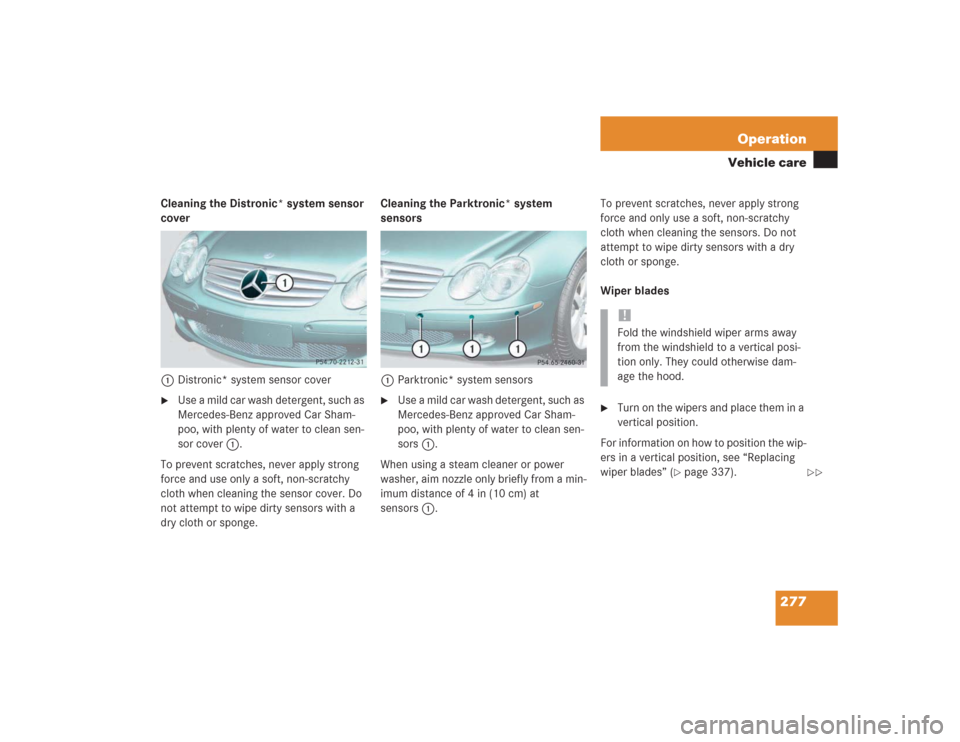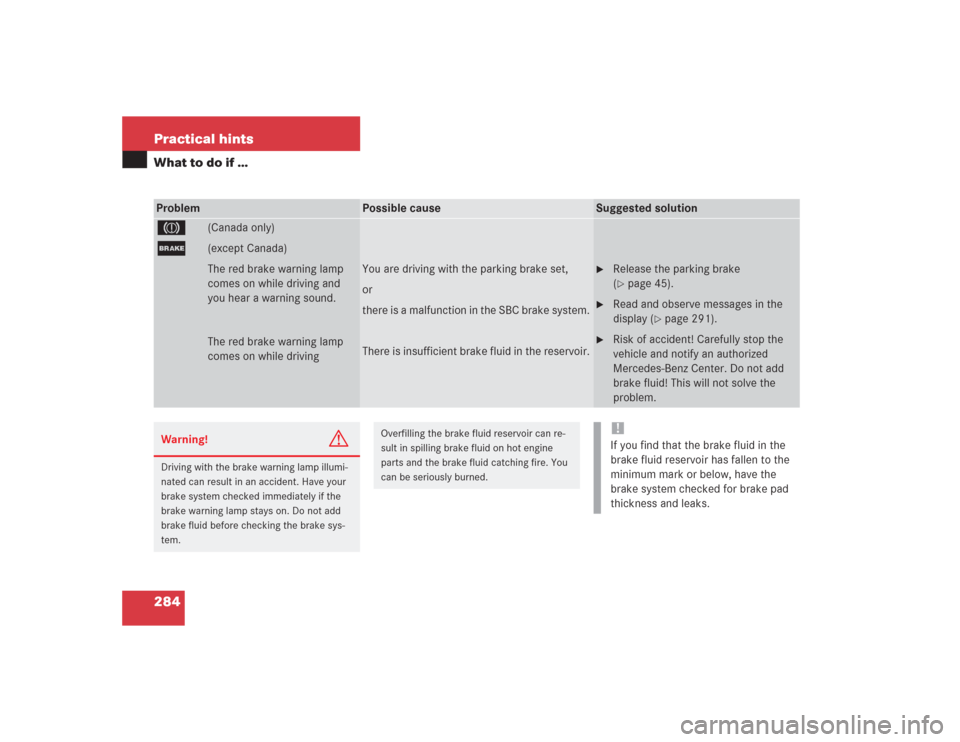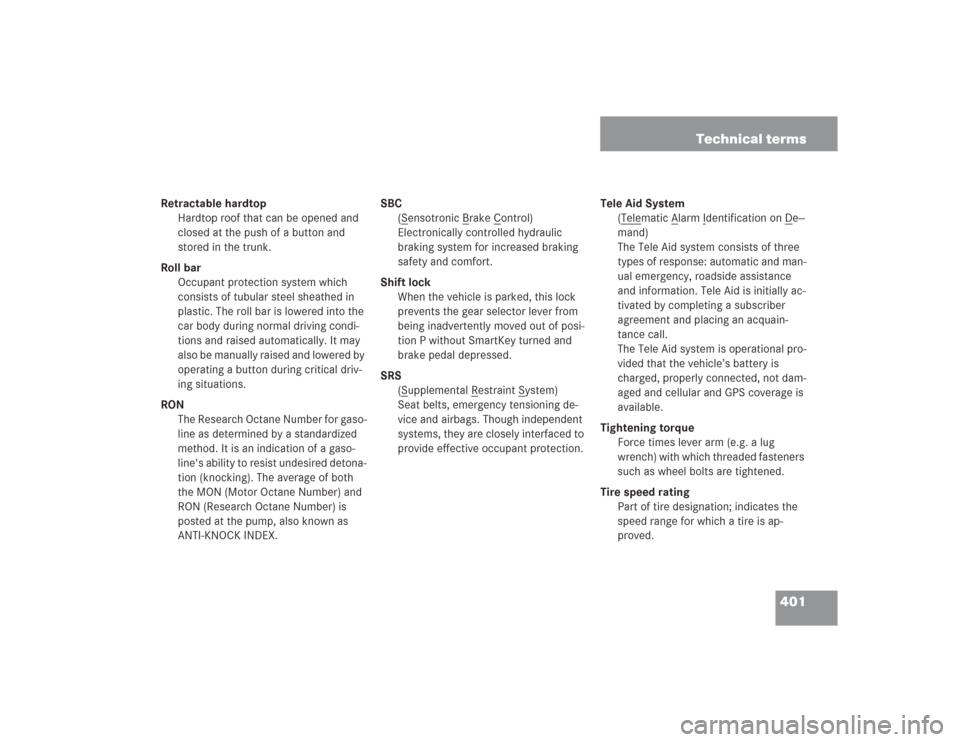Page 278 of 434

277 Operation
Vehicle care
Cleaning the Distronic* system sensor
cover
1Distronic* system sensor cover�
Use a mild car wash detergent, such as
Mercedes-Benz approved Car Sham-
poo, with plenty of water to clean sen-
sor cover1.
To prevent scratches, never apply strong
force and use only a soft, non-scratchy
cloth when cleaning the sensor cover. Do
not attempt to wipe dirty sensors with a
dry cloth or sponge.Cleaning the Parktronic* system
sensors
1Parktronic* system sensors
�
Use a mild car wash detergent, such as
Mercedes-Benz approved Car Sham-
poo, with plenty of water to clean sen-
sors 1.
When using a steam cleaner or power
washer, aim nozzle only briefly from a min-
imum distance of 4 in (10 cm) at
sensors1.To prevent scratches, never apply strong
force and only use a soft, non-scratchy
cloth when cleaning the sensors. Do not
attempt to wipe dirty sensors with a dry
cloth or sponge.
Wiper blades
�
Turn on the wipers and place them in a
vertical position.
For information on how to position the wip-
ers in a vertical position, see “Replacing
wiper blades” (
�page 337).
!Fold the windshield wiper arms away
from the windshield to a vertical posi-
tion only. They could otherwise dam-
age the hood.
��
Page 285 of 434

284 Practical hintsWhat to do if …Problem
Possible cause
Suggested solution
3
(Canada only)
;
(except Canada)
The red brake warning lamp
comes on while driving and
you hear a warning sound.
The red brake warning lamp
comes on while driving
You are driving with the parking brake set,
or
there is a malfunction in the SBC brake system.
There is insufficient brake fluid in the reservoir.
�
Release the parking brake
(�page 45).
�
Read and observe messages in the
display (
�page 291).
�
Risk of accident! Carefully stop the
vehicle and notify an authorized
Mercedes-Benz Center. Do not add
brake fluid! This will not solve the
problem.
Warning!
G
Driving with the brake warning lamp illumi-
nated can result in an accident. Have your
brake system checked immediately if the
brake warning lamp stays on. Do not add
brake fluid before checking the brake sys-
tem.
Overfilling the brake fluid reservoir can re-
sult in spilling brake fluid on hot engine
parts and the brake fluid catching fire. You
can be seriously burned.
!If you find that the brake fluid in the
brake fluid reservoir has fallen to the
minimum mark or below, have the
brake system checked for brake pad
thickness and leaks.
Page 288 of 434

287 Practical hints
What to do if …
Problem
Possible cause
Suggested solution
E
The red DTR indicator lamp
comes on while driving.
You are too close to the vehicle in front of you
to maintain selected speed.
�
Apply the brakes immediately to in-
crease the following distance.
E
The red DTR indicator lamp
comes on while driving and you
hear a warning sound.
�
You are gaining too rapidly on the vehicle
ahead of you.
�
The distance warning system has recog-
nized a stationary obstacle on your prob-
able line of travel.
�
Apply the brakes immediately.
�
Carefully observe the traffic situation.
You may need to brake or maneuver
to avoid hitting an obstacle.
E
The white DTR indicator lamp
comes on while driving.
The Distronic* distance sensor has recog-
nized a vehicle in front of you.
A
The yellow fuel tank reserve
warning lamp lights while driv-
ing.
The fuel level has dropped below the reserve
mark.
�
Refuel at the next gas station
(�page 250).
The fuel cap is not closed tight.
�
Check the fuel cap (
�page 250).
Page 293 of 434
292 Practical hintsWhat to do if …Text messagesLeft display
Right display
Possible cause
Possible solution
ABC
Drive carefully!
The capability of the ABC system is
restricted. This can impair handling.
�
Do not exceed a speed of 50 mph (80 km/h).
�
Visit an authorized Mercedes-Benz Center as
soon as possible.
The vehicle is losing oil.
�
Stop your vehicle as soon as it is safe to do so.
Stop,
car too low
The car is parked on an extremely
uneven surface.
�
Press the vehicle level control button to select
level 2 (
�page 209).
ABC is malfunctioning.
�
Stop and press the ABC button to select a
higher vehicle level (
�page 209).
�
Do not turn steering wheel too far to avoid
damaging the front fenders.
�
Listen for scraping noises.
�
Do not exceed a speed of 50 mph (80 km/h).
�
Visit an authorized Mercedes-Benz Center as
soon as possible.
Page 300 of 434

299 Practical hints
What to do if …
Left display
Right display
Possible cause
Possible solution
T
Brake malfunction!
Stop vehicle!
The SBC brake system is in emer-
gency operation mode. Consider-
ably greater brake pedal force is
required and the stopping distance
is increased.
The maximum speed is limited to
55 mph (90 km/h).
�
Do not drive any further.
�
Stop the vehicle and notify an authorized
Mercedes-Benz Center.
�
Significantly greater force must be applied to
the brake pedal.
�
Call for roadside assistance.
Except Canada:;Canada only:3
Reduced
brake effect
Start engine!
The battery has insufficient voltage
and cannot supply sufficient power
to the SBC brake system.
�
Start the engine.
As soon as the engine is running, the message
disappears.
Increased
braking distance
Start engine!
Warning!
G
Inhalation of exhaust gas is hazardous to
your health. All exhaust gas contains carbon
monoxide, and inhaling it can cause uncon-
sciousness and lead to death.
Do not run the engine in confined areas
(such as a garage) which are not properly
ventilated.
Page 303 of 434
302 Practical hintsWhat to do if …Left display
Right display
Possible cause
Possible solution
Except Canada:;Canada only:3
Service brake
Visit
workshop!
There are malfunctions, but the SBC
brake system is operating normally.
�
Visit an authorized Mercedes-Benz Center as
soon as possible.
Except Canada:;Canada only:3
Brakes overheated!
Drive carefully!
The brake system is overheated due
to an excessive load on the brakes.
�
Relieve the load on the brake system.
�
Drive more smoothly and think ahead to avoid
unnecessary braking.
�
When driving down steep grades, shift into a
lower gear to use the engine’s braking power
(�page 157).
�
Cautiously continue driving so that the air
stream will cool down the brakes.
Except Canada:;Canada only:!
Release
parking brake!
You are driving with the parking
brake set.
�
Release the parking brake (
�page 52).
Page 402 of 434

401 Technical terms
Retractable hardtop
Hardtop roof that can be opened and
closed at the push of a button and
stored in the trunk.
Roll bar
Occupant protection system which
consists of tubular steel sheathed in
plastic. The roll bar is lowered into the
car body during normal driving condi-
tions and raised automatically. It may
also be manually raised and lowered by
operating a button during critical driv-
ing situations.
RON
The Research Octane Number for gaso-
line as determined by a standardized
method. It is an indication of a gaso-
line's ability to resist undesired detona-
tion (knocking). The average of both
the MON (Motor Octane Number) and
RON (Research Octane Number) is
posted at the pump, also known as
ANTI-KNOCK INDEX.SBC
(S
ensotronic B
rake C
ontrol)
Electronically controlled hydraulic
braking system for increased braking
safety and comfort.
Shift lock
When the vehicle is parked, this lock
prevents the gear selector lever from
being inadvertently moved out of posi-
tion P without SmartKey turned and
brake pedal depressed.
SRS
(S
upplemental R
estraint S
ystem)
Seat belts, emergency tensioning de-
vice and airbags. Though independent
systems, they are closely interfaced to
provide effective occupant protection.Tele Aid System
(Tele
matic A
larm I
dentification on D
e--
mand)
The Tele Aid system consists of three
types of response: automatic and man-
ual emergency, roadside assistance
and information. Tele Aid is initially ac-
tivated by completing a subscriber
agreement and placing an acquain-
tance call.
The Tele Aid system is operational pro-
vided that the vehicle’s battery is
charged, properly connected, not dam-
aged and cellular and GPS coverage is
available.
Tightening torque
Force times lever arm (e.g. a lug
wrench) with which threaded fasteners
such as wheel bolts are tightened.
Tire speed rating
Part of tire designation; indicates the
speed range for which a tire is ap-
proved.
Page 403 of 434
402 Technical termsTraction
Force exerted by the vehicle on the
road via the tires.
Vehicle level control
The ground clearance of the vehicle is
automatically controlled according to a
selected setting and speed. The driver
can choose manually within a range of
ground clearance, for example on very
rough roads.
VIN
(V
ehicle I
dentification N
umber)
The number set by the manufacturer
and placed on the body to uniquely
identify each vehicle produced.Voice control system*
Voice control system for car phones,
portable cell phones and audio sys-
tems (radio, CD, etc.).
Wind screen
Screen for deflecting wind from the ve-
hicle interior when the hardtop is low-
ered.
Xenon headlamps
Headlamps which use an electric arc as
the light source and produce a more in-
tense light than filament headlamps.